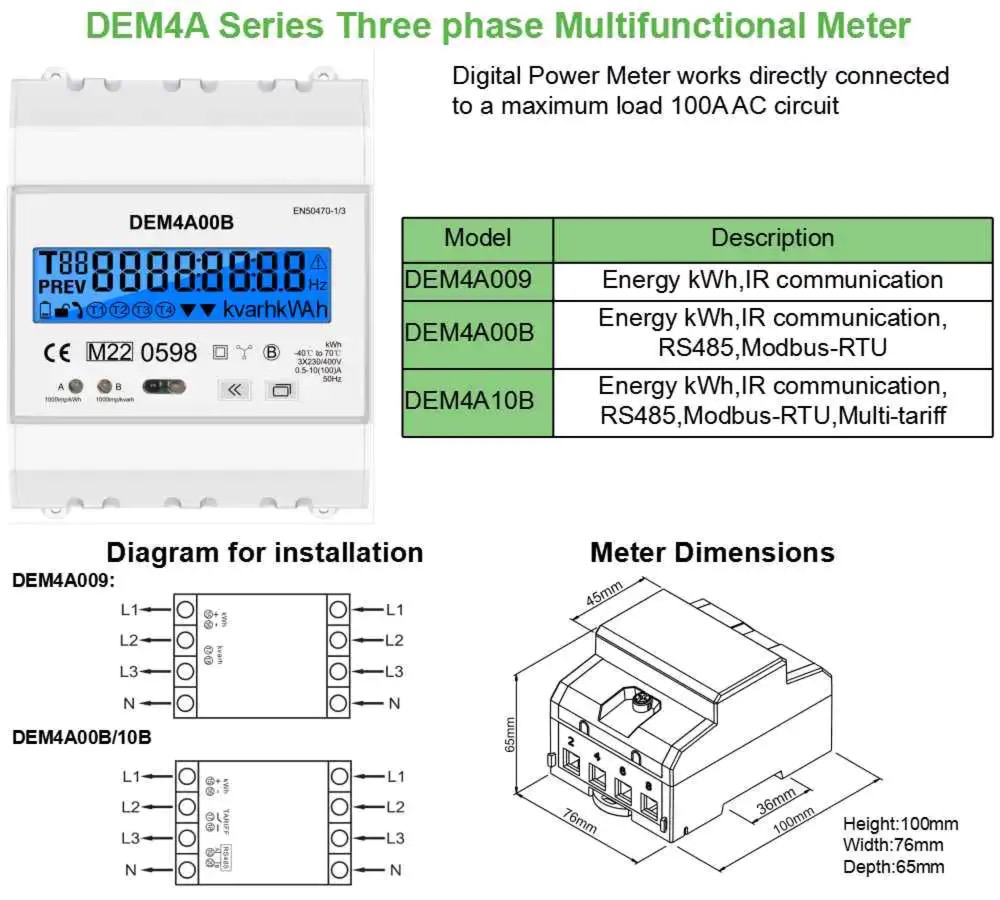DEM4A 5/100A DIN rail 3 Phase 4 wire MID Certificate electric mobilly charge bi-directional energy meter
$80.00
Model
| Brand | Wone |
| Model NO. | DEM4A 5/100A DIN rail 3 Phase 4 wire MID Certificate electric mobilly charge bi-directional energy meter |
| Rated voltage | 3*230(400)V |
| Rated normal current | 0.5-10(100)A |
| Series | DEM4A |
Description
The DEM4A Series Digital Power Meter works directly connected to a maximum load 100A AC circuit
This meter will be applied the MID B&D Certified by SGS UK, proving both it’s accuracy and quality. This certification allows this model to be used for any sub-billing application
Specifications
| Main |
|
|---|---|
| Range | DEM4A |
| Product or Componet Type | Energy meter |
| Country of origin | China |
| Complementary |
|
|---|---|
| Phase | Three Phase |
| Type of measurement | 1-total =forward 2-Total=reverse 3-Total =forward +reverse (default) 4-Total=Forward-Reverse |
| Metering type | Measurement |
| Device Application | Solar Power Energy Charge |
| Accuracy class | Active power 1.0 Reactive power 2.0 |
| Rated Current | 0,5-10(30)A,0,5-10(32)A,0,5-10(40)A,0,5-10(45)A, 0,5-10(50)A,0,5-10(60)A, 0,5-10(80)A,0,5-10(100)A |
| Rated Voltage | 3*230(400)V |
| Network Frequency | 50Hz |
| Technology Type | Electronic |
| Display Type | LCD display(LCD 6+2 = 999999.99kWh) |
| Impulse Constant | 1000imp/kWh(LED) 1000imp/kvarh(LED) |
| Maximum value measured | 99999.99kWh |
| Tariff input | ----------- |
| Communication port protocol | Modbus/DLT645 |
| Communication port support | IR,RS485 |
| Local signalling | ------ |
| Number of inputs | ------- |
| Number of Outputs | -------------- |
| Output voltage | 3*230(400)V |
| Mounting Mode | Clip-on |
| Mounting Support | DIN rail |
| Connections - terminals | ------- |
| Standards | EN50470-1/3 |
| Environment |
|
|---|---|
| IP degree of protection | IP51 indoor |
| Relative humidity | 5…95 % 97 °F (36 °C) |
| Ambient air temperature for operation | -40…70 °C |
| Ambient Air Temperature for Storage | --40…70 °C |
| Operating altitude | 4000 m |
| Dimensions | 116mm*18mm*63mm |
| Packing Units |
|
|---|---|
| Unit Type of Package 1 | PCE |
| Number of Units in Package 1 | 1 |
| Package 1 Height | 65mm |
| Package 1 Width | 76mm |
| Package 1 Length | 100mm |
| Package 1 Weight | 1.000kg |
Dimensions







